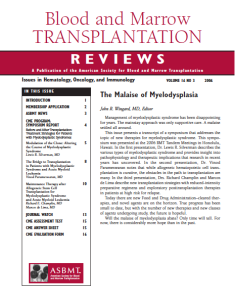by John R. Wingard, Editor
Management of myelodysplastic syndrome has been disappointing for years. The mainstay approach was only supportive care. A malaise settled all around.
This issue presents a transcript of a symposium that addresses the topic of new therapies for myelodysplastic syndrome. This symposium was presented at the 2006 BMT Tandem Meetings in Honolulu, Hawaii. In the first presentation, Dr. Lewis R. Silverman describes the various types of myelodysplastic syndrome and provides insight into pathophysiology and therapeutic implications that research in recent years has uncovered. In the second presentation, Dr. Vinod Parameswaran notes that while allogeneic hematopoietic cell transplantation is curative, the obstacles in the path to transplantation are many. In the third presentation, Drs. Richard Champlin and Marcos de Lima describe new transplantation strategies with reduced-intensity preparative regimens and exploratory posttransplantation therapies in patients at high risk for relapse.
Today there are new Food and Drug Administrationâ•„cleared therapies, and novel agents are on the horizon. True progress has been small to date, but with the number of new therapies and new classes of agents undergoing study, the future is hopeful.
Will the malaise of myelodysplasia abate? Only time will tell. For now, there is considerably more hope than in the past.
Download a PDF version of the full issue.

